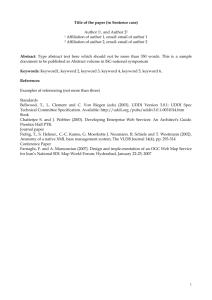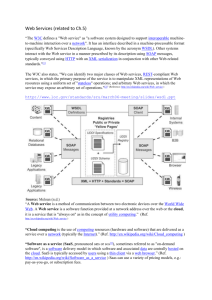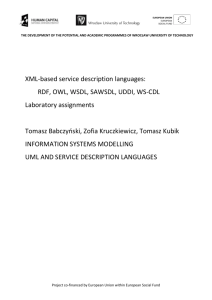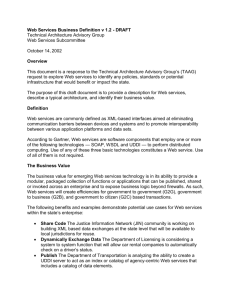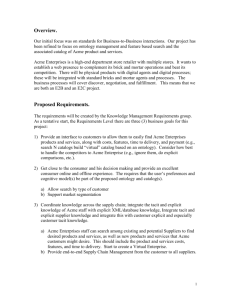UDDI - Community Grids Lab
advertisement
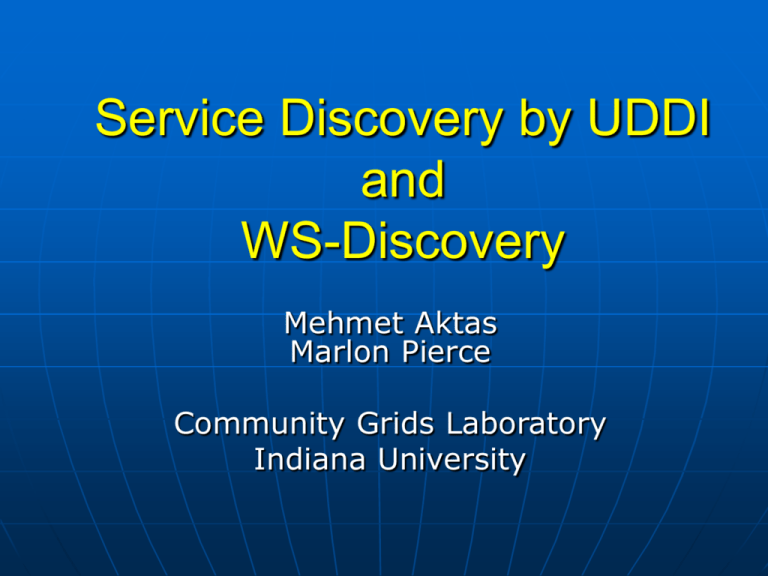
Service Discovery by UDDI and WS-Discovery Mehmet Aktas Marlon Pierce Community Grids Laboratory Indiana University A Registry for WSs: UDDI Universal Description Discovery and Integration (UDDI) • Unified and systematic way to find service providers • roughly equivalent to “phone directory” of web services Specifications • Schemas for service and business description • Query and update API for the registry WS-I compatible Based on XML, HTTP, IP, SOAP, WSDL standards Current status : • UDDI 3.0 has been released in August 2003. • OASIS UDDI Specifications Technical Committee manages and develops UDDI Specifications UDDI Registries Organizing Structure UDDI registry entries store published information about WSs. • White Pages: information such as name, address, i.e. contact details • Yellow Pages: information such as categorization of businesses or services • Green Pages: information such as technical data about services UDDI defines entities to describe businesses and their services - I businessEntity • provides information, including identifiers, contact information etc… [white-pages information] • includes one or more businessService (service entity) elements that represents the services it provides • specifies a categoryBag to categorize the business [yellow-pages information] • a unique key identifies each businessEntity A simple businessEntity Business Key structure Business Name <businessEntity businessKey= “A687FG00-56NM-EFT1-3456-098765432124”> <name>Acme Travel Incorporated</name> <description xml:lang=“en”> Acme is a world leader in online travel services </description> <contacts> <contact useType=“US general”> <personName>Acme Inc.</personName> <phone>1 800 CALL ACME</phone> <email useType=““>acme@acme-travel.com</email> <address>….</address> </contact> </contacts> <businessServices> ... …. </businessServices> <identifierBag> ... </identifierBag> <categoryBag> ... <keyedReference tModelKey= “UUID:DB77450D-9FA8-45D4-A7BC-04411D14E384” keyName=“Electronic check-in” keyValue=“84121801”/> </categoryBag> </businessEntity> Services Category UDDI defines entities to describe businesses and their services - II businessService (service entity) • includes information such as name, description. [white-pages information] • uniquely identified by a service key • specifies a categoryBag to categorize the service [yellow-pages information] • contains a list of bindingTemplates which in turn contains tModelInstanceDetails encoding the technical service information [green-pages information] • includes reference to its host with a businessKey A simple businessService structure Service Key <businessService serviceKey= “894B5100-3AAF-11D5-80DC-002035229C64” businessKey=“D2033110-3AAF-11D5-80DC-002035229C64”> <name>ElectronicTravelService</name> <description xml:lang=“en”>Electronic Travel Service</description> <bindingTemplates> <bindingTemplate bindingKey= “6D665B10-3AAF-11D5-80DC-002035229C64” serviceKey=“89470B40-3AAF-11D5-80DC-002035229C64”> <description> SOAP-based e-checkin and flight info </description> <accesssPoint URLType=“http”> http://www.acme-travel.com/travelservice </accessPoint> <tModelInstanceDetails> <tModelInstanceInfo tModelKey=“D2033110-3BGF-1KJH-234C-09873909802”> ... </tModelInstanceInfo> </tModelInstanceDetails> </bindingTemplate> </bindingTemplates> <categoryBag> ... </categoryBag> </businessService> Service Name Binding Template tModelDetails Category UDDI Information Model Rompothong, Senivongse 03 UDDI Query UDDI Search API allows users to query for service providers that provide particular service. A UDDI query may be for • A business entity Using business name, business key or business category (i.e. find_business()) • A list of publisher assertions Using business key (i.e. find_relatedBusiness()) • A business service Using the business key of service key and service name (i.e. find_service()) • Service key of a bussiness entity Using a binding template (i.e. find_binding()) • A set of business entities and business services adopting same tModel Using a tModel (i.e. find_tModel()) After finding the requited UDDI entry, a set of API is used to get details of those entries from UDDI • get_businessDetail(), get_serviceDetail(), get_bindingDetail(), get_tModelDetail() UDDI and WSDL relationship Adams, Boeyen 02 tModel A WSDL document is registered as a tModel into UDDI registry • In order to describe a service in more expressive way, an external information is referenced where the type and format of this information should be arbitrary. • UDDI Specs. leaves the responsibility of defining such arbitrary information types and formats to programmers. tModel is a UDDI construct to refer an interface describing WSDL document. The tModel idea: • to better describe a service we tend to reference information • such information type or format should not be anticipated • replacing such information about a service with a unique key provides a reference to arbitrary information types tModels for Categorization Using categorization, UDDI directory can be queried for specific type of services. Each classification in a taxonomical system is registered as a tModel. Three standard taxonomies cited by UDDI are • North American Industry Classification System (NAICS) taxonomy – an industry classification • The Universal Standard Products and Services Code System (UNSPSC) taxonomy – a classification of products and services • The International Organization for Standardization Geographic taxonomy (ISO 3166) A simplified tModel definition <tModel tModelKey=““> <name>http://www.travel.org/e-checkin-interface</name> <description xml:lang=“en”> Standard service interface definition for travel services </description> <overviewDoc> <description xml:lang=“en”> WSDL Service Interface Document </description> <overviewURL> http://www.travel.org/services/e-checkin.wsdl </overviewURL> </overviewDoc> <categoryBag> ... </categoryBag> </tModel> An example on How do we bind a WSDL to UDDI? Step by Step <?xml version="1.0" encoding="utf-8"?> <definitions name="StockQuote" targetNamespace="http://example.com/stockquote/" xmlns:tns=http://example.com/stockquote/ xmlns:xsd1="http://example.com/stockquote/schema/" xmlns:soap=http://schemas.xmlsoap.org/wsdl/soap/ xmlns="http://schemas.xmlsoap.org/wsdl/"> <types> <schema targetNamespace="http://example.com/stockquote/schema/" xmlns="http://www.w3.org/2001/XMLSchema"> <element name="TradePriceRequest"> <complexType><all><element name="tickerSymbol" type="string"/></all></complexType> </element> <element name="TradePrice"> <complexType><all><element name="price" type="float"/></all></complexType> </element> </schema> A sample WSDL file </types> <message name="GetLastTradePriceInput"> - 1 portType <part name="body" element="xsd1:TradePriceRequest"/> input </message> - 1 binding <message name="GetLastTradePriceOutput"> output <part name="body" element="xsd1:TradePrice"/> - 1 service </message> <portType name="StockQuotePortType"> - 1 port <operation name="GetLastTradePrice"> <input message="tns:GetLastTradePriceInput"/> <output message="tns:GetLastTradePriceOutput"/> </operation> </portType> <binding name="StockQuoteSoapBinding" type="tns:StockQuotePortType"> …. </binding> <service name="StockQuoteService"> <port name="StockQuotePort" binding="tns:StockQuoteSoapBinding"> <soap:address location="http://location/sample"/> </port> </service> </definitions> “Input\Output” Details “Method” Specification “Binding” Details UDDI portType tModel <tModel tModelKey="uuid:e8cf1163-8234-4b35-865f-94a7322e40c3" > <name> StockQuotePortType tModel name </name> <overviewDoc> <overviewURL> overviewDoc http://location/sample.wsdl <overviewURL> <overviewDoc> <categoryBag> <keyedReference tModelKey="uuid:d01987d1-ab2e-3013-9be2-2a66eb99d824" keyName=”portType namespace” keyValue=”http://example.com/stockquote/” /> <keyedReference tModelKey="uuid:6e090afa-33e5-36eb-81b7-1ca18373f457" keyName=”WSDL type” keyValue="portType" /> </categoryBag> </tModel> categoryBag <tModel tModelKey="uuid:49662926-f4a5-4ba5-b8d0-32ab388dadda"> <name> StockQuoteSoapBinding </name> <overviewDoc> <overviewURL> http://location/sample.wsdl overviewDoc </overviewURL> </overviewDoc> <categoryBag> <keyedReference tModelKey="uuid:d01987d1-ab2e-3013-9be2-2a66eb99d824" keyName=”binding namespace” keyValue=”http://example.com/stockquote/” /> <keyedReference tModelKey="uuid:6e090afa-33e5-36eb-81b7-1ca18373f457" keyName=”WSDL type” keyValue="binding" /> <keyedReference tModelKey="uuid:082b0851-25d8-303c-b332-f24a6d53e38e" keyName=”portType reference” keyValue="uuid:e8cf1163-8234-4b35-865f-94a7322e40c3" /> <keyedReference tModelKey="uuid:4dc74177-7806-34d9-aecd-33c57dc3a865" keyName=”SOAP protocol” keyValue= “uuid:aa254698-93de-3870-8df3-a5c075d64a0e” /> <keyedReference tModelKey="uuid:e5c43936-86e4-37bf-8196-1d04b35c0099" keyName=”HTTP transport” keyValue=" uuid:68DE9E80-AD09-469D-8A37-088422BFBC36" /> <keyedReference tModelKey="uuid:c1acf26d-9672-4404-9d70-39b756e62ab4" keyName=”uddi-org:types” keyValue="wsdlSpec" /> </categoryBag> </tModel> UDDI binding tModel a keyedReference categoryBag UDDI businessService and bindingTemplate <businessService serviceKey="102b114a-52e0-4af4-a292-02700da543d4" businessKey="1e65ea29-4e0f-4807-8098-d352d7b10368"> <name>Stock Quote Service</name> <bindingTemplates> <bindingTemplate bindingKey="f793c521-0daf-434c-8700-0e32da232e74” serviceKey="102b114a-52e0-4af4-a292-02700da543d4"> <accessPoint URLType="http"> http://location/sample </accessPoint> <tModelInstanceDetails> <tModelInstanceInfo tModelKey="uuid:49662926-f4a5-4ba5-b8d0-32ab388dadda"> <description xml:lang="en"> text here… </description> <instanceDetails> <instanceParms>StockQuotePort</instanceParms> </instanceDetails> </tModelInstanceInfo> <tModelInstanceInfo tModelKey="uuid:e8cf1163-8234-4b35-865f-94a7322e40c3"> <description xml:lang="en"> The wsdl:portType that this wsdl:port implements. </description> </tModelInstanceInfo> </tModelInstanceDetails> </bindingTemplate> </bindingTemplates> <categoryBag> ….. </categoryBag> </businessService> business name bindingTemplate tModelInstanceDetails tModelInstanceInfo Query example - I Find the businessService for a WSDL service <find_service generic=”2.0” xmlns=”urn:uddi-org:api_v2”> <categoryBag> <keyedReference tModelKey=”uuid:6e090afa-33e5-36eb-81b7-1ca18373f457” keyName=”WSDL type” keyValue=”service” /> <keyedReference tModelKey="uuid:d01987d1-ab2e-3013-9be2-2a66eb99d824" keyName=”service namespace” keyValue=”http://example.com/stockquote/” /> <keyedReference tModelKey="uuid:2ec65201-9109-3919-9bec-c9dbefcaccf6" keyName=”service local name” keyValue="StockQuoteService" /> </categoryBag> </find_service> Query example - II Find tModel for portType name <find_tModel generic=”2.0” xmlns=”urn:uddi-org:api_v2”> <name>StockQuotePortType</name> <categoryBag> <keyedReference tModelKey=”uuid:6e090afa-33e5-36eb-81b7-1ca18373f457” keyName=”WSDL type” keyValue=”portType”/> <keyedReference tModelKey=”uuid:d01987d1-ab2e-3013-9be2-2a66eb99d824” keyName=”portType namespace” keyValue=”http://example.com/stockquote/”/> </categoryBag> </find_tModel> Query example - III Find bindings for portType <find_tModel generic=”2.0” xmlns=”urn:uddi-org:api_v2”> <categoryBag> <keyedReference tModelKey=” uuid:6e090afa-33e5-36eb-81b7-1ca18373f457” keyName=”WSDL type” keyValue=”binding”/> <keyedReference tModelKey=”uuid:082b0851-25d8-303c-b332-f24a6d53e38e” keyName=”portType reference” keyValue=”uuid:e8cf1163-8234-4b35-865f-94a7322e40c3”/> </categoryBag> </find_tModel> Recent Updates on UDDI Specs. richer mapping of WSDL 1.1 to UDDI v.2 and v.3 • portType is supported. • Note that portType replaced by Interface in WSDL 2. any logical/physical WSDL structure is supported new querying abilities on UDDI registries • Given the namespace of a wsdl:portType, find the tModel that represents that portType. • Given the namespace a wsdl:binding, find the tModel that represents that binding. • Given a tModel representing a portType, find all tModels representing bindings for that portType. • Given a tModel representing a portType, find all bindingTemplates that represent implementations of that portType. • Given a tModel representing a binding, find all bindingTemplates that represent implementations of that binding. • Given the namespace of a wsdl:service, find the businessService that represents that service. http://www.oasis-open.org/committees/uddispec/doc/tn/uddi-spec-tc-tn-wsdl-v200-20031104.htm WSDL data model UDDI data model mapping of WSDL 1.1 to UDDI V2 data model Limitations of UDDI tModels are not stored in UDDI registries themselves. A unique identifier referencing a tModel is contained in the registries. There is no uniform way of querying about services, service interfaces and classifications. UDDI does not support WSDL security More Limitations… Out-of-date service documents in UDDI registries. No dynamic discovery functionality Limited query capabilities: search for services restricted to WS name and its classification Future Extensions to UDDI Information on spatial and temporal availability of a service Information on pricing, payment and delivery channels Information on degree of security and confidentiality of service request Information on consumption, quality of service and reputation Recent research to extend UDDI Capabilities UDDIe an Extension to UDDI v.2 support the notion of “Blue Pages” brings the notion of leasing for registry entries: brings the notion of service properties as WS metadata dynamic service life period services may have one or more properties service discovery is based on service properties Current status: • UDDIe is developed by the School of Computer Science atCardiff University. • Link to UDDIe procjet. http://www.wesc.ac.uk/projects/uddie/uddie/ User Defined -- may use some predefined ontology or metadata format (can be strings or number) DD/MM/YYYY hh:mm:ss Number of times lease renewed UDDIe architecture BusinessEntity BusinessService categoryBag ServiceName ServiceDescription PropertyBag ServiceLease UDDIe BindingTemplate TModel UDDI Resources - I UDDI pages, www.uddi.org OASIS UDDI Specifications Technical Committee manages and developes UDDI Specifications http://www.oasis-ope-open.org/committees/uddi-spec/index.shtml UDDI V2 Specifications http://www.oasis-open.org/committess/uddispec/tcspecs.shtml#uddiv2 UDDI V3 Specifications http://www.oasis-open.org/committess/uddispec/tcspecs.shtml#uddiv3 A recent technical note on WSDL and UDDI relationship http://www.oasis-open.org/committees/uddi-spec/doc/tn/uddi-spectc-tn-wsdl-v200-20031104.htm Microsoft UDDI, http://uddi.microsoft.com IBM UDDI, http://www-306.ibm.com/software/solutions/webservices/uddi UDDI Reference http://www.zvon.org/xxl/uddiReference/Output UDDI Resources - II Development Tools • Microsoft UDDI SDK, For .NET framework, Windows. http://msdn.microsoft.com/library/default.asp?url=/nhp /Default.asp?contentid=28001204 • UDDI4J, UDDI4J is a Java class library that provides an API to interact with a UDDI registry. Open source http://www-124.ibm.com/developerworks/oss/uddi4j/ • jUDDI, jUDDI is a Java implementation, BSD License. http://freshmeat.net/projects/juddi/ • SOAP UDDI, SOAP UDDI is a reference implementation of the UDDI specification http://freshmeat.net/projects/soapuddi/?topic_id=250 Shortcomings of UDDI is addressed with WS-Discovery Specs. UDDI provides discovery for services that are always connected to the network. • need a discovery system for sometimes connected services. UDDI has to handle with out-of-date service entry information • Need a discovery system for dynamically updated entries. UDDI provides discovery for only registered services • Need a discovery for services not exist in any central registry. UDDI provides a central registry • Need a discovery system which performs on distributed registries on ad hoc and managed networks WS-Discovery defines a multicast protocol to locate services allows dynamic discovery of services in ad hoc and managed networks • discovery of temporarily-connected services providing interface to portable devices such as hand-helds, pocket pc, etc… enables discovery of resource-limited service implementations enables discovery of services by type and within scope leverages other Web service specifications for secure, reliable, transacted message delivery scales to a large number of endpoints, by defining a multicast suppression behavior if a service registry (discovery proxy) is available on the network. WS-Discovery Specifications http://ftpna2.bea.com/pub/downloads/ws-discovery.pdf WS-Discovery WS-Discovery Specs. defines • A WSDL providing an interface for service discovery • A multicast discovery protocol • XML Schemas for WS-Discovery messages Current Status: • WS-Discovery and related specifications are provided for use as-is and for review and evaluation only. • Microsoft, BEA, Canon and Intel are contributors. Limitations • It does not provide liveness information on services • It does not define a rich data model for service description • It is not an internet-scale discovery Concepts Target Service • An endpoint that makes itself available for discovery. Client • An endpoint that searches for Target Service(s). Discovery Proxy • An endpoint that facilitates discovery by Clients among a large number of endpoints. Discovery Proxies are an optional component of the architecture. Type • An identifier for a set of messages an endpoint sends and/or receives (e.g., a portType). Scope • An extensibility point that may be used to organize Target Services into logical groups. Metadata • Information about the Target Service; includes, but is not limited to, network addresses where a Target Service may be reached, transports and protocols it understands, Types it implements, and Scopes it is in. WS-Discovery Message Exchange WS-Discovery Client States WS Discovery Multicast Protocol Protocol Assignments PORT: 3702 IPv4 multicast address: 239.255.255.250 End User Client Target service Discovery Proxy Discovery Proxy (D.P.) It is indented to be a registry for web services. • D.P. could be UDDI, LDAP, etc… When D.P. is discovered, clients use a discovery-specific protocol to communicate with one or more of them. WS-Discovery does not define neither the discovery-specific protocol nor the interaction between WS-Discovery service and Registry such as UDDI. • details are left up to the programmers. D.P. announces itself to the client when it detects Probe and Resolve messages. (Hello message) D.P. makes another announcement when it prepares to leave the system. (Bye message) WS-Discovery Multicast Messages Hello • A message sent by a Target Service when it joins a network; the message contains key information for the Target Service. Bye • A best-effort message sent by a Target Service when it leaves a network. Probe • A message sent by a Client searching for a Target Service by Type and/or Scope. Resolve • A message sent by a Client searching for a Target Service by name. WS-Discovery WS metadata Metadata includes, but is not limited to, • • • • EndpointReference Policy, Types, Scopes. MetadataVersion information is kept to track the changes in cached metadata • It is incremented by >= 1 whenever there is a change in the metadata of the Target Service. Scope and Type of a Service <xs:element name='Scope' > <xs:complexType> <xs:simpleContent> <xs:extension base='xs:anyURI' > <xs:attribute name='MatchBy' type='xs:anyURI' /> </xs:extension> </xs:simpleContent> </xs:complexType> </xs:element> <xs:element name='Scopes' > <xs:simpleType> <xs:list itemType='xs:anyURI' /> </xs:simpleType> </xs:element> <xs:element name='Types' > <xs:simpleType> <xs:list itemType='xs:QName' /> </xs:simpleType> </xs:element> Scope: anyURI Type : QName Hello Message It is a one-way multicast message sent by a Target Service It is sent under two conditions • When target service joins a network • When metadata changes Hello message can be also a unicast message sent by a Discovery Proxy in response to any Probe or Resolve. A hello message may include metadata • client listens to Hello messages and stores metadata for corresponding Target Service <s:Envelope xmlns:a='http://schemas.xmlsoap.org/ws/2003/03/addressing' xmlns:d='http://schemas.xmlsoap.org/ws/2004/02/discovery' xmlns:i='http://printer.example.org/2003/imaging' xmlns:p='http://schemas.xmlsoap.org/ws/2002/12/policy' xmlns:s='http://www.w3.org/2003/05/soap-envelope' > HELLO Message <s:Header> <a:Action> http://schemas.xmlsoap.org/ws/2004/02/discovery/Hello </a:Action> <a:MessageID> uuid:0a6dc791-2be6-4991-9af1-454778a1917a </a:MessageID> <a:To>http://schemas.xmlsoap.org/ws/2004/02/discovery</a:To> <d:AppSequence InstanceId='1077004800' MessageNumber='1' /> </s:Header> <s:Body> Metadata fields: <d:Hello> endpoint reference, <a:EndpointReference> policy, type and <a:Address> scope of the service uuid:98190dc2-0890-4ef8-ac9a-5940995e6119 </a:Address> <p:Policy> .... </p:Policy> </a:EndpointReference> <d:Types>i:PrintBasic i:PrintAdvanced</d:Types> <d:Scopes>ldap:///ou=engineering,o=examplecom,c=us</d:Scopes> <d:MetadataVersion>75965</d:MetadataVersion> </d:Hello> </s:Body> </s:Envelope> Bye Message It is a one-way multicast message sent by a Target Service. It is sent when T.S. is preparing to leave the network Bye message can be also a unicast message sent by a Discovery Proxy when D.P. is leaving network. Client listens to Bye messages to invalidate cached metadata about T.S. <s:Envelope xmlns:a='http://schemas.xmlsoap.org/ws/2003/03/addressing' xmlns:d='http://schemas.xmlsoap.org/ws/2004/02/discovery' xmlns:s='http://www.w3.org/2003/05/soap-envelope' > <s:Header> <a:Action> http://schemas.xmlsoap.org/ws/2004/02/discovery/Bye Bye Message </a:Action> <a:MessageID> uuid:337497fa-3b10-43a5-95c2-186461d72c9e </a:MessageID> <a:To>http://schemas.xmlsoap.org/ws/2004/02/discovery</a:To> <d:AppSequence InstanceId='1077004800' MessageNumber='2' /> </s:Header> <s:Body> Endpoint reference. <d:Bye> Note: More metadata field <a:EndpointReference> elements can be included in a <a:Address> Bye message. uuid:98190dc2-0890-4ef8-ac9a-5940995e6119 </a:Address> </a:EndpointReference> </d:Bye> </s:Body> </s:Envelope> Probe Message It is a one-way multicast message sent by a Client Service. It is sent If a client has not discovered any Discovery Proxies to find T.S. of a given Type and/or in a given Scope. It may be a unicast message, if a client knows the network address of a T.S., the Probe MAY be sent directly to that network address Client will listen to responses (Probe Match) • Client may wait for a sufficient number of responses. • Client may repeat the Probe several times until the Client is convinced that no further responses will be received. Probe Message <s:Envelope xmlns:a='http://schemas.xmlsoap.org/ws/2003/03/addressing' xmlns:d='http://schemas.xmlsoap.org/ws/2004/02/discovery' xmlns:i='http://printer.example.org/2003/imaging' xmlns:s='http://www.w3.org/2003/05/soap-envelope' > <s:Header> <a:Action> http://schemas.xmlsoap.org/ws/2004/02/discovery/Probe </a:Action> <a:MessageID> uuid:0a6dc791-2be6-4991-9af1-454778a1917a </a:MessageID> <a:To>http://schemas.xmlsoap.org/ws/2004/02/discovery</a:To> </s:Header> <s:Body> <d:Probe> Type <d:Types>i:PrintBasic</d:Types> Scope <d:Scope MatchBy='http://schemas.xmlsoap.org/ws/2004/02/discovery/ldap'> ldap:///ou=engineering,o=examplecom,c=us </d:Scope> </d:Probe> </s:Body> </s:Envelope> Probe Match Message It is a unicast message. It is sent by a Target Service. If a Target Service matches a Probe, the Target Service MUST respond with a Probe Match message. It may include metadata about service. <s:Envelope xmlns:a='http://schemas.xmlsoap.org/ws/2003/03/addressing' xmlns:d='http://schemas.xmlsoap.org/ws/2004/02/discovery' xmlns:i='http://printer.example.org/2003/imaging' xmlns:p='http://schemas.xmlsoap.org/ws/2002/12/policy' xmlns:s='http://www.w3.org/2003/05/soap-envelope' > <s:Header> <a:Action> http://schemas.xmlsoap.org/ws/2004/02/discovery/ProbeMatch </a:Action> <a:MessageID> uuid:e32e6863-ea5e-4ee4-997e-69539d1ff2cc Probe Match Message </a:MessageID> <a:RelatesTo> uuid:0a6dc791-2be6-4991-9af1-454778a1917a </a:RelatesTo> <a:To> http://schemas.xmlsoap.org/ws/2003/03/addressing/role/anonymous </a:To> </s:Header> <s:Body> service metadata <d:ProbeMatch> <a:EndpointReference> elements <a:Address> uuid:98190dc2-0890-4ef8-ac9a-5940995e6119</a:Address> <p:Policy> <d:SoapHttpRequestReplyAddress> http://prn-example/PRN42/b42-1668-a </d:SoapHttpRequestReplyAddress> </p:Policy> </a:EndpointReference> <d:Types>i:PrintBasic i:PrintAdvanced</d:Types> <d:Scopes> ldap:///ou=engineering,o=examplecom,c=us ldap:///ou=floor1,ou=b42,ou=anytown,o=examplecom,c=us </d:Scopes> <d:MetadataVersion>75965</d:MetadataVersion> </d:ProbeMatch> </s:Body> </s:Envelope> Resolve Message It is one-way multicast message sent by a Client. A Client may send a Resolve message • If a Client has an Endpoint Reference for a T.S., and does not have enough metadata to bootstrap communication with the T.S. • If it has not discovered any Discovery Proxies Resolve Message <s:Envelope ...> <s:Header ...> <a:Action ...> http://schemas.xmlsoap.org/ws/2004/02/discovery/Resolve </a:Action> <a:MessageID ...>xs:anyURI</a:MessageID> [<a:ReplyTo ...> <a:Address ...>xs:anyURI</a:Address> ... </a:ReplyTo>]? <a:To ...>xs:anyURI</a:To> ... </s:Header> <s:Body ... /> </s:Envelope> Resolve Match It is a unicast message. It is sent by a Target Service. If a Target Service matches a Resolve, the Target Service MUST respond with a Resolve Match message. It may include metadata about service. Resolve Match Message <s:Envelope ...> <s:Header ...> <a:Action ...> http://schemas.xmlsoap.org/ws/2004/02/discovery/ResolveMatch </a:Action> <a:MessageID ...>xs:anyURI</a:MessageID> <a:RelatesTo ...>xs:anyURI</a:RelatesTo> <a:To ...>xs:anyURI</a:To> ... </s:Header> <s:Body ...> <d:ResolveMatch ...> <a:EndpointReference ...> <a:Address ...>xs:anyURI</a:Address> [<a:ReferenceProperties ...>...</a:ReferenceProperties>]? ... [<p:Policy>policy expression</p:Policy>]? </a:EndpointReference> [<d:Types ...>list of xs:QName</d:Types>]? [<d:Scopes ...>list of xs:anyURI</d:Scopes>]? <d:MetadataVersion ...>xs:nonNegativeInteger</d:MetadataVersion> ... </d:ResolveMatch> </s:Body> </s:Envelope> Shortcomings of WS-Discovery Specifications. WS-Discovery does not provide liveness information on WSs. WS-Discovery protocol assignment is limited to a multicast address. • This creates dependency to multicasting system (hardware or software). WS-Discovery does not provide rich metadata model on WS information. WS-Discovery does not provide a discovery-proxy protocol for interactions between clients and registries.

